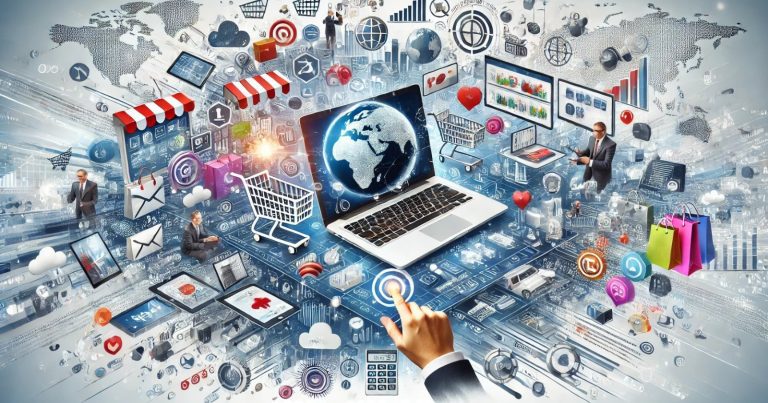E business is buying or selling, marketing, and providing customer service in the bid space using digital platforms such as web pages and apps. It involves operations carried out over the Internet to offer products and services worldwide. This article explores different B2B, B2C, and C2C models in e-business and outlines the merits and demerits of e-business, their components, and real-life applications. Learn how e-business is revolutionising businesses and creating new growth opportunities.
What is E Business?
E business or electronic business refers to business conduct over the Internet. This includes purchasing and selling products or services, supply chain management, customer relationships, and even an organisation’s human resource and finance functions. The difference between E Business and e-commerce is that e-commerce only deals with transactions over the Internet. In contrast, E Business covers more activities associated with the electronic handling of business functions.
E Businesses Examples include Amazon, an online marketplace selling products globally; Netflix, which provides digital streaming services; Zomato and Swiggy, online food delivery platforms connecting restaurants to customers; and Tata Cliq, an Indian e commerce firm offering fashionable and lifestyle e-products.
Components of E Business
E Business tools help companies manage operations, improve efficiency, and enhance their customers experience. The most important tools include e commerce platforms, CRM systems, SCM solutions, and ERP software for a particular business function.
- E-commerce: Selling or buying something online. It facilitates any business to reach a global audience and operate 24/7.
- Online Customer Relationship Management: It will manage all the online customer interactions. Thus, it will track customer’s behaviour and improve service quality.
- Supply Chain Management: All inventory, suppliers, and logistics are online. SCM ensures that all goods and information flow is efficient.
- Enterprise Resource Planning (ERP): Integrating all business processes for efficiency. Streamlines operations by consolidating data within departments.
E Business vs. E Commerce
While E Business and e-commerce are often used interchangeably, they differ in scope and purpose.
E Business is the entire online business activity, including inventory management, marketing, and CRM. It is not merely buying and selling but encompasses online business operations. ERP and CRM software help companies to manage their processes efficiently in the digital space.
E-commerce focuses on purchasing and selling products or services through online media. It involves the sales and trading process on sites like Flipkart and Amazon. The e-commerce model employs tools like online payment gateways and e-commerce platforms for efficient and secure customer transactions.
| Aspect | E Business | E Commerce |
| Definition | Includes all online business operations. | It focuses only on buying and selling online. |
| Scope | Broader, including supply chain CRM. | Limited to sales and transactions. |
| Examples | Online inventory management marketing. | Shopping on Flipkart and Amazon. |
| Tools Used | ERP, CRM software. | E commerce platforms, payment gateways. |
Types of E Business
E business can be categorised into several classes depending on the parties involved. The significant kinds of e-business are B2B (Business-to-Business), B2C (Business-to-Consumer), C2C (Consumer-to-Consumer), and C2B (Consumer-to-Business). Every model has distinctive characteristics, benefits, and challenges.
Business-to-Business (B2B)
In a B2B business, there is a transaction between two companies, such as a wholesaler selling goods to a retailer. The model will be a business operation where businesses trade in goods or services with one another. Alibaba and IndiaMART are classic examples of the B2B marketplace, bridging businesses worldwide.
There are various advantages of B2B transactions. It deals with a huge number of orders, which leads to economies of scale for businesses. Companies generally enter long-term partnerships, which means stable revenue and constant business growth. This model suits businesses that aim for reliability and long-term collaboration.
- Advantages of B2B E Business: With benefits such as large-scale orders bringing in more significant revenue, secure relations because of long-term client contracts ensuring a regular income, and efficient supply chains that improve processes and lower costs, B2B E Business benefits.
- Disadvantages of B2B E Business: B2B E Business has a sophisticated sales process that involves long-term negotiations and contracts, a smaller customer base focuses on only one target market, and has more competition with other large businesses.
Business-to-Consumer (B2C)
B2C, or Business-to-Consumer, is the type of business selling goods or services directly to customers on the web. The approach is majorly based on fulfilling the requirements of consumers, and companies primarily use it to target a large crowd. Some popular examples of B2C are Amazon and Flipkart.
B2C has several advantages. It helps businesses reach a global market, thus expanding their market. Direct customer interaction gives the business good feedback to improve its products and services. Also, B2C platforms enable companies to offer a wide range of goods to meet the customer’s demands.
- Advantages of B2C E Business: By reaching millions of customers across the globe, easy shopping with products and services being available 24/7 at one’s convenience, thereby reducing costs for not requiring bricks and mortar facilities and saving overheads.
- Disadvantages of B2C E Business: High competition requires strong marketing; successful customer retention is difficult due to the lack of possibilities to build long-term loyalty; and logistics can get very complex with deliveries and returns.
Consumer-to-Consumer (C2C)
C2C stands for Consumer-to-Consumer; it is the direct buying and selling of a product or service from each other via online platforms. This model connects sellers and buyers without involving a traditional business. Examples include, most popularly, eBay and OLX.
C2C offers several advantages. It does not require much business infrastructure and is thus available to many to participate. Such platforms provide an extensive variety of products to suit the different needs of customers. Moreover, C2C enables easy and direct transactions, making buying and selling easier for users.
- Advantage of C2C E Business: C2C e business is inexpensive in terms of set-up expense because the platforms carry out transactions, easy access for individuals to offer their products or services, and available variety of products–original, used items at competitive prices.
- Disadvantages of C2C E Business: There is a lack of trust since fraud or low-quality products may be present, and the payment issues are also relatively more compared to B2C, and less customer support can be offered.
Consumer-to-Business (C2B)
C2B, or Consumer-to-Business, is a model where consumers sell products or services to businesses. This includes freelance work, user-generated content, or other contributions consumers offer. Popular interfaces like Upwork and Fiverr make it easy for consumers to connect with businesses that seek their services.
C2B has its advantages in providing people with flexible working methods to work on their terms. Businesses will also benefit from having access to on-demand services and cost-efficient, asset-light, and made-to-order services from independent experts. This model forms a win-win relationship between consumers and businesses.
- Advantages of C2B E Business: Freelancing provides flexibility to work with various businesses, global reach to clients worldwide, and cost-effective hiring for companies with no long-term commitments.
- Disadvantages of C2B E Business: Freelancers experience unstable incomes and intense competition in their project hunt while facing no employment security without having fixed contracts and employee benefits.
What is E Business Model?
An e-business model is how a business conducts its activities online for value creation, product or service provision, and revenue generation. It will use digital platforms and technologies to buy, sell, market, and provide customer service. These three standard e-business models are B2B (Business to Business), B2C (Business to Consumer), and C2C (Consumer to Consumer). Companies sell directly to their customers or interact with other companies through websites, apps, or online marketplaces. E-business models allow companies more extensive reachability, reduced operating costs, and increased efficiency.
Advantages of E Business
E Business has brought a complete transformation in the business operation and its communication with customers. This has numerous benefits; it is highly favoured by businesses globally.
- Global Access: Access towards customers at large and even international markets to get expanded along different geographical horizons.
- Cost Efficiency: No physical infrastructure is required for E Business; hence, no operational costs like rent and utilities have to be incurred.
- 24/7 Availability: The web platform enables businesses to operate online and never sleep, offering customers constant offerings of products and services.
- Better customer experience: E-commerce uses chatbots, personal recommendations, and quick delivery to enhance customer happiness.
- Better insight regarding data: Such platforms enable businesses to track customer preferences, buying behaviour, and trends for decision-making.
Disadvantages of E Business
Despite numerous benefits, E Businesses also face some challenges they must overcome to succeed. Disadvantages are Cybersecurity Risks, Technology Dependence, High Competition etc.
- Cybersecurity Risks: Hacking, Data breaches, and phishing attacks are vulnerabilities of online businesses.
- Technology Dependence: Technical problems like website downtime or software malfunction will disrupt business.
- High Competition: Online businesses face tough competition due to easy entry into the E Business environment.
- Limited Personal Contact: Customers will miss the personal touch of face-to-face contact.
- Logistics Challenges: Shipping, delivery, and return handling are always challenges to any E Business and cost lots of money.
E Business FAQs
1. What is e business?
E business or Electronic business means doing business through the internet or online, that is, sales, marketing, and customer support.
2. How to start an e business?
Starting an electronic business involves choosing a niche, hosting your own website, adding payment options, and marketing your business online.
3. What is e business and what is e commerce? How are they different?
E Business involves all aspects of online business activities, whereas e-commerce refers to only selling and buying on the Internet.
4. What are the types of e business?
The different types of E Business are B2B, B2C, C2C, and C2B models.
5. What are the limitations of e business?
Limitations include risks in terms of cybersecurity, technology dependence, high competition, and logistics problems.


